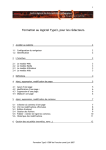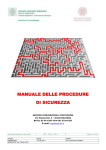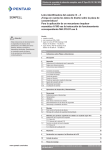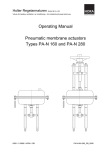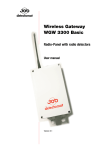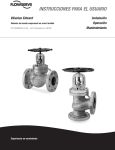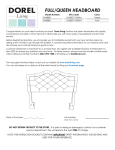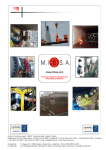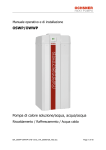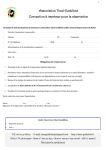Download Bopp & Reuther 0-50-00003.4 Instrucciones de servicio y de
Transcript
Bopp & Reuther Sicherheits- und Regelarmaturen Instrucciones de servicio y de mantenimiento Válvulas de seguridad SiC con carga de muelle Operating and Maintenance Instructions SiC-Safety Relief Valves Spring Loaded Tipo SiC 11 Capota abierta Type SiC 11 open bonnet Tipo SiC 13 Estándar Type SiC 13 conventional Tipo SiC 14 con fuelle de pliegues Type SiC 14 balanced bellow Variantes de ejecución: Options: - Conexiones roscadas - Conexiones de brida - G Estanqueidad al gas -A Estanqueidad al gas, puede ventilarse -B Bloqueable -Thread Connection -Flange Connection -G gastight -A packed lifting lever -B with test rod Código de materiales: Material-Code: 00 acero fundido no aleado 1.0619/WCB 04 acero fundido aleado 1.4408/CF8M 00 Carbon Steel 04 Stainless Steel 1.0619/WCB 1.4408/CF8M Hoja, sheet, de, of, de page B A - Ahrens Hauert Illius SRE-E SRE-E SRE-E Nombre,n Dep., dep., ame,nom Rev. hecho, modif., dép. issued by, revised by, 30.10.01 29.09.00 27.06.00 Föllmer Haracska Ha SRE-E SRE-K SRE Fecha, date Nombre, name, Dep., dep., Fecha, date dép. checked by, contrôlé par nom édité par modifé par controlado, 30.10.01 1 09.10.00 27.06.00 N°,No. 15 0-50-00003.4 Bopp & Reuther Sicherheits- und Regelarmaturen 1/1&1/1/1 1/1/2 1/1/3 1/2 1/3 2/1 2/5/1&2/5/1/1 2/5/1/2 2/5/1/3 2/5/2 2/5/3 2/7 2/8 2/9 2/10 2/12 2/15/1 2/15/2 2/15/3 Fig. 4 Rev. -AB Fig. 1 Carcasa / Body Tubo / Pipe Brida soldada de revestimiento / Sleeve Welding Flange Tubuladura de entrada / Nozzle Brida / Flange Campana elevadora / Lifting Bell Campana elevadora/placa inf. / Lifting bell/Lower Plate Husillo / Spindle Clavija cilíndrica / Socket Pin Fuelle de pliegues / Bellows Placa superior / Upper Plate Junta plana / Gasket Tampa intermedia / Guide Casquillo de presión / Guide Bushing Clavija cilíndrica / Socket Pin Plato de muelles / Spring Washer Capota / Bonnet Tornillo tensor / Adjusting Screw Contratuerca /Adjusting Screw Nut Fig. 2 2/16 2/17 2/18 3/1 3/3/1 3/3/2 3/4 3/7 3/8 3/10 4 5/1 5/2 5/4 5/5 5/6 5/7 5/8 10 Fig. 3 Husillo / Spindle Tuerca de ventilación / Spindle Nut Tuerca / Nut Calota de ventilación / Lifting Cap Eje de ventilación / Lifting Shaft Palanca de ventilación / Lifting Lever Anillo tórico / O-Ring Pasador de aletas / Tension Pin Tornillo de cierre / Blanking Plug Tornillo bloqueador / Gagging Bolt Disco / Disc Seguro de disco / Disc Retainer Junta plana / Gasket Junta plana / Gasket Tornillo cilíndrico / Socket Head Screw Bola / Ball Tornillo cilíndrico / Socket Head Screw Tornillo limitador de carrera / Lift Limiting Screw Muelle / Spring Fig. 5 Nr., No. 0-50-00003.4 Blatt, sheet, page 2 von,of, de 15 Bopp & Reuther 1. Funcionamiento 1.1 Las válvulas de seguridad soplan luego que la presión del muelle que se ejerce sobre el disco (4) es superada por la presión del medio. La campana elevadora (2/1;2/5/1;2/5/1/1) sirve como ayuda de elevación. 1.2 Las tolerancias para la presión de abertura y de cierre están en el margen de las normas válidas: ASME Sec. VIII, AD y TRD. 1.3 El fuelle de pliegues (2/5) en la válvula tipo SiC14 prohibe la entrada del medio en la cámara del muelle protegiéndolo contra corrosión. 1.4 La contrapresión efectiva es compensada por el fuelle de pliegues (2/5) porque la superficie central del disco (4) y la superficie eficaz del fuelle de pliegues (2/5/2) son iguales y la cámara de la capota (2/15/1) comunica con la presión atmosférica. Así la contrapresión externa no tiene influencia en la presión de reacción de la válvula. 1.5 Una rotura del fuelle de pliegues (2/5) en la versión cerrada significa que la presión de reacción se aumenta por la mitad de la presión externa efectiva. 1.6 La carrera está delimitada por un tope (ver fig. 13). 2. Transporte y condiciones de entrega Transportar la válvula posiblemente sin sacudidas ni vibraciones. Las válvulas de seguridad suministradas por la Bopp & Reuther han sido controladas en fábrica y ajustadas a la presión de reacción deseada y selladas con plomo. Una placa con el estampado NB o la contraseña de componente constructivo del TÜV está fijada en el costado de la capota (2/15/1). En esta placa se indican también la presión de reacción y el número de encargo de la fábrica (n° WA). En el control en nuestra fábrica, p.ej. por el TÜV etc., este control está también documentado por un estampado. 2.1 El barnizado de la fundición de acero no aleado (1.0619/WCB) se realiza con pintura de polvo de zinc. En cima de este se puede aplicar cualquier otra pintura. Las válvulas de acero fundido no aleado (1.4408/CF8M) no son barnizadas. Rev. -AB Nr., No. 1. Operation 1.1 Safety valves blow off as soon as the spring force acting on the disc (4) is surmounted by the medium pressure. In this connection the lifting bell (2/1;2/5/1;2/5/1/1) operates as lifting assistance. 1.2 The tolerances for the opening and closing pressure are within the range of the given prescriptions, ASME Sec. VIII, AD and TRD. 1.3 The bellows (2/5) in the valve type SiC14 avoids the entering of the medium into the spring chamber and protects against corrosion. 1.4 The existing back pressure is balanced by the bellows (2/5) such that the average disc face (4) and the effective area of the bellows (2/5/2) are the same and the bonnet chamber (2/15/1) is connected with atmospheric pressure. Thus, the superimposed back pressure has no influence on the set pressure of the valve. 1.5 A rupture of the bellows (2/5) in case of the closed execution means that the set pressure increases by the amount of the existing superimposed back pressure. 1.6 The lift is limited by a stop (see figure 13). 2. Transport, Delivery Condition The valves shall be transported to the site as shock- and shakeproof as possible.The safety valves delivered by Bopp & Reuther have been tested in the factory, adjusted to the desired set pressure and leaded. A label with the NBstamp or the TÜV type approval, respectively, is fastened at the connecting flange of the bonnet (2/15/1) to the body (1/1/1) above the set screw (1/1/12). The set pressure and the works order number (w. o. no.) are also indicated on this label.In case of an inspection in our factory, f. i. by TÜV etc., this test is also identified by application of a stamp. 2.1 The painting of unalloyed cast steel (1.0619/WCB) is made with inorganic zinc colour. Afterwards, every further colour painting can be applied. Valves made of alloyed material (1.4408/CF8M) do not get any painting. 0-50-00003.4 Hoja, sheet, page 3 de,of,d e 15 Bopp & Reuther 3. Montaje Limpiar las partes de la instalación que se van a segurar antes del montaje de la válvula. Quitar las calotas de protección en la entrada y la salida de la válvula, pero sólo mismo antes del montaje de la válvula o un ensayo. Atención: El asiento en este válvula ha sido lapeado a un nivel óptico y por eso puede facilmente ensuciarse por suciedad o partículas. Si se utiliza la válvula para fines de ensayo antes de la instalación final, hay que secar cuidadosamente las partes interiores de la válvula después de los ensayos y después volver a ponerse las calotas protectoras. El dispositivo de prueba de la válvula así como el fluido de prueba (gas, aire) deben estar absolutemente limpios. Debe asegurarse que ni la unidad de prueba ni la entrada de válvula sean contaminadas con suciedad o partículas antes de realizarse un ensayo o la instalación final de la válvula. 3.1 ¡Montar la válvula de seguridad con husillo (2/16;2/5/1/2) en posición vertical! El montaje y el desmontaje de la válvula en la instalación o en el caballete de ensayo debe realizarse sólo al aplicar una llave bifurcada en la tubuladura de entrada (1/2). No se debe dar vuelta a la parte superior de la válvula o a la carcasa (1/1; 1/1/1), tampoco para tal vez alinear la tubería de salida, pues podría aflojarse la unión roscada entre la carcasa y la tubuladura de entrada podiendo producirse con esto fugas de la válvula para dentro y para fuera. 3.2 Para el transporte está asegurada la palanca de ventilación (3/3/2). Hay que quitar este seguro sólo después del montaje y volver a ponerlo después de un ensayo y antes de otro transporte. 3.3 Hay que disponer la tubería de soplado de modo que facilite la corriente En caso de líquidos o medios que producen condensado, la tubería debe obtener una inclinación al salir de la válvula. En la posición más baja de la tubería hay que poner un desagüe suficientemente dimensionado o un tubo de purga de condensado. Al producirse contrapresión en la tubería de soplado, la descarga debe automaticamente volver a cerrarse después de purgar el condensado. Rev. -AB Nr., No. 3. Installation The system elements to be protected have to be cleaned before mounting the valve. Remove protective caps at the inlet and outlet of the valve. This, however, shall only be done immediately before mounting or testing the valve. ATTENTION: The seat in this valve are lapped to optical flatness and can easily be damaged by dirt or other particles. If removed for test, dry valve interior and reseal until just before installation. Test equipment and test gas or air must be absolutely clean. Care must betaken to ensure that neighter test equipment nor valve inlet contains any dirt particles before testing or installing this valve. 3.1 Mount the safety valve with spindle (2/16;2/5/1/2) in perpendicular position ! Mounting and dismounting of the valve within the system or on the test stand may only be performed by applying a fork wrench at the inlet nozzle (1/2). It is not allowed to turn at the valve top or at the body (1/1; 1/1/1), even not for a possible centering of the outlet pipe as otherwise the screwed connection between the body and the nozzle risks to loosen and, thus, the valve might become leak inside and outside. 3.2 As transport protection the lifting lever (3/3/2) is wired. This wire may only be removed after the installation and must be applied again after a possible test and new transport. 3.3 The discharge pipe has to be arranged in favourable flow direction. In case of liquids and media generating condensate the pipe must have a slope away from the valve. At the deepest place of the pipe a sufficiently dimensioned drain or a condensate discharge has to be provided. If back pressure is built up in the discharge pipe the discharge has to close again automatically after having drained the condensate. 0-50-00003.4 Hoja, sheet, page 4 de,of,d e 15 Bopp & Reuther 3.4 Las válvulas de seguridad del tipo SiC14 tienen una perforación roscada "b" en la calota (2/15/1) (ver fig. 2 y 3). A través de esta perforación roscada se ventila la cámara de la calota (2/15/1), esto es, es unida con presión atmosférica. Para los medios tóxicos fácilmente inflamables se puede enroscar un tubo para purgar el material de una fuga. A este tubo puede montarse una posibilidad de prueba (p.ej. grifo de cierre y manómetro) para detectar una fuga del fuelle de pliegues (2/5). Atención: El tubo enroscado no debe penetrar en la cámara interior de la capota ya que esto puede bloquear el muelle. Evite absolutamente la presión en la calota (2/15/1) porque la presión de reacción aumentaría más aquella presión en la calota. Controle regularmente el fuelle de pliegues (2/5). 4. Ajuste de la presión de reacción La válvula de seguridad está asegurada con plomo contra un desajuste no autorizado de la presión de reacción. Un reajuste de la presión de reacción debe ser hecho sólo por personal instruido y responsable en la presencia de un perito (consulta con el fabricante). 4.1 La presión de reacción puede ajustarse en los límites definidos por la Bopp & Reuther SR GmbH. Modo de proceder: - Hay que quitar el precinto entre la capota (2/15/1) y la calota (3/1). - Desenroscar los tornillos (5/5) y quitar la calota de ventilación (3/1). - Aflojar la contratuerca (2/15/3). - Al girar el tornillo tensor (2/15/2) en sentido horario se aumenta la presión de reacción, al girar en sentido opuesto se la reduce. Advertencia importante: Para evitar una danificación de la superficie de asiento (4;1/1/3) o el fuelle de pliegues (2/5) (torsión), al ajustar el tornillo tensor (2/15/2), hay que sujetar el husillo (2/16) en la tuerca (2/18). - Después de terminar el ajuste de la presión apretar la contratuerca (2/15/3). - Montar la calota de ventilación (3/1), utilizando un sello nuevo (5/4). - Hay que observar que el precinto entre la calota de ventilación (3/1) y la capota (2/15/1) vuelva a ser puesta. - Al realizarse la homologiación en nuestra fábrica por un perito reconocido, el control queda documentado mediante estampado. Rev. -AB Nr., No. 3.4 Safety valves of the type SiC14 have a threaded boring "b" (s. figure 2 and 3) in the bonnet (2/15/1). Via this threaded boring the bonnet chamber (2/15/1) is aerated i. e. connected to atmospheric pressure. In case of toxic, easily inflammable media a pipe may be screwed to discharge a leakage. To this pipe a testing possibility (f. i. isolating valve and manometer) can be mounted in order to detect leakage of the bellows (2/5). Attention: The screwed pipe must not protrude into the bonnet inside as this might block the spring. The building up of pressure within the bonnet (2/15/1) must absolutely be avoided because otherwise the set pressure would increase by this built-up pressure. A regular control of the bellows (2/5) must be carried out. 4. Adjustment of the Set Pressure The safety valve is leaded against unauthorized modification of the set pressure. An adjustment of the set pressure may only be carried out by specialist and responsible personnel with the presence of an expert (contact the manufacturer). 4.1 The set pressure may be adjusted within certain limits according to the definition of Bopp & Reuther SR GmbH. Procedure: - The lead between the bonnet (2/15/1) and the cap (3/1) must be removed --Screw out the screws (5/5) and take of the lifting cap (3/1) - Release the adjusting screw nut (2/15/3) - Turning of the adjusting screw (2/15/2) clockwise increases the set pressure, turning in opposite direction decreases the set pressure Important Note: In order to avoid a damage of the seat area (4;1/1/3) or the bellows (2/5) (torsion) the spindle (2/16) has to be held at the nut (2/18) when adjusting the adjusting screw (2/15/2). - After the pressure adjustment has been terminated tighten the counter nut (2/15/3). - Mount the lifting cap (3/1), when doing this utilize new gasket (5/4) - Mind that the leading between the lifting cap (3/1) and the bonnet (2/15/1) is applied again - In case of inspection in our factory by an authorized expert the test is marked with a stamp 0-50-00003.4 Hoja, sheet, page 5 de,of,d e 15 Bopp & Reuther 4.2 Al cambiar la presión de ajuste, B & R suministrará el muelle apropiado (10). 5. Mantenimiento 5.1 Control 5.1.1 Hay que comprobar en ciertos intervalos el funcionamiento de las válvulas de seguridad. (nos referimos a la regulación para recipientes bajo presión (DruckbehV) o a la directiva de aparatos bajo presión (DGRL). 5.1.2 Al accionar la palanca de ventilación (3/3/2) (dirección A ver fig. 3), el disco (4) queda descargado de modo que el disco (4) se levanta de su asiento por causa de la presión de servicio efectiva. Este levantamiento/ventilación es posible cuando la presión de servicio es por lo menos 75% de la presión de reacción. En este proceso de ventilación es suficiente una pequeña carrera de la válvula. Hay que observar que la presión de servicio sea inferior a la presión de cierre de la válvula. 5.1.3 Si las válvulas de seguridad tienen fugas, los cuerpos ajenos pegados a la superficie de junta pueden soplarse al levantar el disco (4). Si con esto no se alcanzara suficiente obturación, en la siguiente pausa del servicio se deberán rectificar las superficies de junta. 5.2 Rectificado de los asientos de válvula 5.2.1 Para rectificar el asiento de válvula es posible el desmontaje mediante una ayuda de retención sin desajustar la presión de reacción. Modo de proceder: - Aflojar el precinto entre la calota de ventilación (3/1) y la capota (2/15/1). - Desenroscar los tornillos (5/5) y quitar la calota de ventilación (3/1). - Marcar posición de la tuerca de ventilación (2/17). - Desenroscar la tuerca de ventilación (2/17) y la tuerca (2/18). - Como herramienta auxiliar, empujar un casquillo distanciador sobre el husillo (2/16) (ver fig. 6). - Enroscar la tuerca (2/18) sobre el husillo (2/16) hasta que apriete contra el casquillo distanciador. - Girar la tuerca (2/18) con llave anular/bifurcada 2 hasta 3 vueltas más. - El ajuste del muelle está retenido y el disco se ha levantado de su asiento. - Desenroscar los tornillos (5/7). - Retirar toda la parte superior de la válvula. - Quitar el seguro del disco (5/1) (ver fig. 7). - Sacar el disco (4) de la campana elevadora (2/1;2/5/1). - Las superficies de obturación en el disco (4) y la tubuladura de entrada (1/2) están liberadas. Rev. -AB Nr., No. 4.2 When changing the set pressure the suitable spring (10) has to be defined by B & R. 5. Maintenance 5.1 Control 5.1.1 Safety valves have to be tested in regular intervals with regard to their readiness for service. (In this connection refer to the pressure vessels specification (DruckbehV) or pressure equipment device (PED), respectively. 5.1.2 By operating the lifting lever (3/3/2) (direction A see figure 3) the disc (4) is relieved to that the disc (4) detaches the seat supported by the existing service pressure. This lifting is possible if the service pressure is at least 75% of the set pressure. For this lifting operation a small valve lift is sufficient. The service pressure has to be lower than the closing pressure of the valve. 5.1.3 If safety valves are leak foreign substances possibly adhering to the sealing face may be blown away by lifting of the disc (4). If a tightness cannot be obtained by this the sealing faces have to be regrinded during the next stop. 5.2 Grinding of the Valve Seats 5.2.1 For grinding of the valve seat the dismanthing is possible by means of a blocking aid without modifying the set pressure. Procedure: - Release the lead between the lifting cap (3/1) and the bonnet (2/15/1). - Screw out the screws (5/5) and take off the lifting cap (3/1) - Mark the position of the lifting nut (2/17). - Unscrew the lifting nut (2/17) and the nut (2/18). - As an auxiliary tool push the distance sleeve over the spindle (2/16) (s. figure 6). - Screw the nut (2/18) on the spindle (2/16) until it presses against the distance sleeve. - Continue to turn the nut (2/18) by two until three turns with a fork wrench/ring wrench. - The Spring Adjustment is Locked and the Disc is Lifted off the Seat. - Screw out the screws (5/5). - Remove the whole valve top. - Remove the disc retainer (5/1) (s. figure 7). - Take the disc (4) out of the lifting bell (2/1;2/5/1). - The sealing faces at the disc (4) and the nozzle (1/2) are free. 0-50-00003.4 Hoja, sheet, page 6 de,of,d e 15 Bopp & Reuther Fig. 7 Fig. 6 5.2.2 El lapeado se realiza, como mostrado en fig. 8 y 9, mediante discos de lapeado y pasta abrasiva de grano fino o en una máquina lapeadora. 5.2.3 La vuelta "e" en el disco (4) y el escalón "f" en la tubuladura de entrada (1/2) pueden repasarse hasta una medida mínima. Si esta medida es menos, será necesario cambiar las piezas (ver fig. 10). Advertencia importante: Las danificaciones mayores del asiento deben eliminarse antes del lapeado mediante procesamiento mecánico o utilizando esmeriladores gruesos (ver punto 5.3.1). El lapeado manual se realiza al girar a derecha y a izquierda con ligera presión, en lo que es necesario aprovecharse de la superficie mayor posible del disco lapeador. El disco lapeador debe siempre cubrir por completo la superficie del asiento. El rectificado está terminado cuando la superficie del asiento ya no tiene daños. Limpiar los asientos después del rectificado. Para acabar el pulido, aplicar pasta pulidora y kerosene en el reverso no utilizado del disco lapeador y pulir con movimientos rotativos y con suave presión. Quitar la pasta pulidora y controlar las superficies del asiento. 5.2.4 Utilizar nuevas juntas (5/2;5/4). 5.2.5 Ensamblaje ATENCIÓN: - Retener el ajuste del muelle e implantar la parte superior de la válvula en la carcasa (1/1;1/1/1), apretar los tornillos (5/7) igualmente en sentido diagonal. La hendidura entre la capota (2/15/1) y la carcasa debe tener el mismo ancho en toda la circunferencia. - Aflojar cuidadosamente la tuerca (2/18) hasta que el disco (4) vuelva a sentarse sobre el asiento de válvula. - ¡Quitar el casquillo distanciador! - Ensamblaje siguiente en secuencia invertida como descrito bajo 5.2.1. Rev. -AB Nr., No. 5.2.2 The grinding is made, as shown in figures 8 and 9, with lapping discs and fine-grained grinding paste or on a lapping machine. 5.2.3 The turned groove "e" at the disc (4) and the heel "f" at the nozzle pipe (1/2) may be reworked to a minimum dimension. If this dimension is fallen below the parts have to be replaced (s. figure 10). Important Note: Important seat damages have to be removed before lapping by mechanical treatment f. i. by utilizing rough abrasive cloth (see point 5.3.1). The hand-lapping is made by turning to and fro with light pressure the largest possible surface of the lapping disc having to be utilized. The lapping disc must always fully cover the seat area. The grinding is terminated if the seat area does not show damages anymore. Clean the seats after the grinding. Repolish with the unused back of the lapping disc by means of polishing paste and petroleum with rotating movements and light pressure. Remove the polishing paste and check the seat areas. 5.2.4 Utilize new gaskets (5/2;5/4). 5.2.5 Assembly ATTENTION: - In case of locked spring adjustment Insert The valve top into the body (1/1;1/1/1), uniformly tighten the screws (5/7) diagonally. The gap between the bonnet (2/15/1) and the body must have the same width on the whole circumference. - Carefully loosen the nut (2/18) until the disc (4) is again positioned on the valve seat. - Remove the distance sleeve ! - The further mounting is performed in reversed order than that described in 5.2.1. 0-50-00003.4 Hoja, sheet, page 7 de,of,d e 15 Bopp & Reuther 5.2.6 La presión de reacción puede desajustarse por el trabajo posterior en el asiento. Debería controlarse y de nuevo ajustarse si necesario (ver punto 4). Después de terminar estos trabajos, poner el seguro de precinto entre la capota (2/15/1) y la calota de ventilación (3/1). 5.2.6 The set pressure may perhaps change because of the reworking of the seat. It has to be checked and adjusted again if necessary (see par. 4). After having terminated these operations the leaded seal between the bonnet (2/15/1) and the lifting cap (3/1) has to be applied. Fig. 9 Fig. 8 Fig. 10 Rev. -AB Nr., No. 0-50-00003.4 Hoja, sheet, page 8 de,of,d e 15 Bopp & Reuther 5.3 Desmontaje de válvula Para cambiar el muelle o la limpieza de las piezas individuales, proceda así: - Aflojar el precinto entre la calota de ventilación (3/1) y la capota (2/15/1). - Desenroscar los tornillos (5/5) y quitar la calota de ventilación (3/1). - Marcar posición de la tuerca de ventilación (2/17). - Desenroscar la tuerca de ventilación (2/17) y la contratuerca (2/18). - Aflojar la contratuerca (2/15/3). - Desenroscar el tornillo tensor (2/15/2) en sentido antihorario hasta notificarse una descarga notable por el muelle (10). - Desenroscar los tornillos (5/7) diagonalmente opuestos. - Desenroscar los dos otros tornillos (5/7) alternadamente hasta desestablecer una eventual pretensión restante del muelle. - Quitar la capota (2/15/1). - Mediante el husillo (2/16) pueden extraerse por arriba todas las piezas internas de la carcasa (1/1). - Desmontar el seguro del disco (5/1) (ver fig. 7). Versión de fuelle de pliegues SiC14, d012,2: - Al desenroscar el husillo (2/16) del fuelle de pliegues (2/5) tipo SiC14, debe fixarse sólo la campana elevadora/placa inferior (2/5/1) (ninguna torsión en el fuelle de pliegues). Versión de fuelle de pliegues SiC14, d017: El husillo (2/5/1/2) forma una unidad con el fuelle de pliegues (2/5) y no puede desmontarse. 5.3.1 Desmontaje de la tubuladura de entrada (1/2) Esto por ejemplo es necesario cuando los daños en el asiento están tan grandes que es necesario un acabado mecánico. - Quitar la parte inferior de la válvula de la tubería. - Desenroscar la tubuladura de entrada (1/2) de la carcasa (1/1). Hay que fixar la carcasa (1/1) a la brida cuadrangular (conexión de la capota). - Trabajo mecánico en la tubuladura de entrada (1/2) es posible (procesado posterior max. ver fig. 10). 5.3.2 Desmontaje de la ventilación (ver fig. 5) Si la ventilación en el eje de ventilación tiene fugas, hay que cambiar el anillo tórico. - Golpear fuera el pasador con aletas (3/7) con el mandril (diámetro 2,5mm). - Extraer el eje de ventilación (3/3/1-3/3/2) de la calota de ventilación (3/1), desmontar el anillo tórico. - Antes de un nuevo montaje limpiar las piezas, sobre todo las superficies de junta del anillo tórico en el eje de ventilación (3/3/1) y en la calota de ventilación (3/1). Rev. -AB Nr., No. 5.3 Valve Disassembly The procedure for replacing the spring or cleaning the components is as follows: - Release the lead between the lifting cap (3/1) and the bonnet (2/15/1). - Screw out the screws (5/5) and take off the lifting cap (3/1) - Mark the position of the lifting nut (2/17). - Unscrew the lifting nut (2/17) and the counter nut (2/18). - Release the counter nut (2/15/3). - Unscrew the adjusting screw (2/15/2) counterclockwise until a sensible relieving by the spring (10) is stated. - Screw out two diagonally opposite screws (5/7) - Screw out the two other screws (5/7) uniformly and alternately until a possibly existing residual prestress of the spring is relieved - Lift off the bonnet (2/15/1). - With the spindle (2/16) all internal parts may be removed upwards out of the body (1/1) - Disassemble the disc retainer (5/1) (see fig. 7). Bellows design SiC14, d0 12.2: - When screwing the spindle (2/16) out of the bellows (2/5) type SiC14, only the lifting bell/lower plate (2/5/1) may be fixed (no torsion on the bellows). Bellows design SiC14, d0 17: The spindle (2/5/1/2) forms a unit with the bellows (2/5) and may not be disassembled 5.3.1 Dismounting of the Nozzle (1/2) This is necessary, f. i., if the damages at the seat are so important that a mechanical treatment is required. - Remove the valve bottom from the pipe. - Screw the nozzle (1/2) out of the body (1/1). In this connection the body (1/1) has to be fastened at the square flange (bonnet connection). - The mechanical treatment at the nozzle (1/2) can be carried out (max. rework see figure 11). 5.3.2 Dismounting of the Lifting (s. Figure 5) If the lifting is leak at the lifting shaft the O-ring has to be replaced. - Drive the tension pin (3/7) out with a drift (diameter 2.5mm). - Draw the lifting shaft (3/3/1-3/3/2) out of the lifting cap (3/1), dismount the O-ring. - Before remounting the parts have to be cleaned; this is particularly true for the O-ring sealing faces at the lifting shaft (3/3/1) and in the lifting cap (3/1). 0-50-00003.4 Hoja, sheet, page 9 de,of,d e 15 Bopp & Reuther 5.4 Montaje de válvula 5.4.1 Montaje de la tubuladura de entrada La obturación entre la carcasa (1/1) y la tubuladura de entrada (1/2) es un borde obturador metálico. Antes de enroscar la tubuladura de entrada (1/2) en la carcasa (1/1) hay que cuidar que en las dos partidas las roscas y las superficies de junta sean absolutamente limpias. Durante el proceso de enroscar hay que fixar la carcasa (1/1) a la brida cuadrangular (conexión de la capota). El par de apriete para la tubuladura de entrada (1/2) es 400Nm +10%. Esto vale para todas las válvulas independientemente del tipo de conexión (roscas o bridas). 5.4.2 Montaje de la parte superior de la válvula SiC13 (ver fig. 1) En el montaje hay que utilizar las siguientes obturaciones nuevas (2/7;5/2;5/4). Modo de proceder: - Enchufar la clavija cilíndrica (2/10) en la perforación de husillo prevista (2/16). - Empujar la campana elevadora (2/1) desde arriba sobre la clavija (2/10) hasta el tope (ver fig. 11). - Poner bola (5/6) entre el disco (4) y la campana elevadora (2/1). - Montar el seguro del disco (5/1) (ver fig. 12) - Cubrir el husillo (2/16) desde arriba con el casquillo de presión (2/9) y la tapa intermedia (2/8) (diámetro exterior pequeño hacia abajo). - Medir carrera (ver fig. 13). 5.4.2.1 Fijar husillo en posición de carrera max., montar parte superior en la carcasa. - Poner la junta plana (2/7) en el adaptador de la capota (2/15/1) y enchufar las piezas antes nombradas juntas con los platos de muelle (2/12) y el muelle (10) en el grupo premontado capota (consisten en 2/15/1;2/15/2; 2/15/3). El tornillo tensor (2/15/2) está desenroscado tanto para arriba que el plato de muelle queda por arriba en la capota. - Como herramienta auxiliar, empujar un casquillo distanciador sobre el husillo (2/16) (ver fig. 6). - Atornillar la tuerca (2/18) sobre el husillo y así alzar el husillo tanto hasta que sobre la campana elevadora (2/1) la tapa intermedia (2/8) y la junta (2/7) sean ligeramente apretadas hacia la superficie de obturación en el adaptador de capota (2/15/1). - Poner la junta plana (5/2) en el adaptador de la carcasa (1/1;1/1/1). - Introducir la pieza superior premontada en el adaptador de carcasa y apretar los tornillos (5/7) diagonal y homogeneamente. La hendidura entre la capota (2/15/1) y la carcasa (1/1;1/1/1) debe tener el mismo ancho en toda la circunferencia. Rev. -AB Nr., No. 5.4 Valve Assembly 5.4.1 Mounting of the Inlet Nozzle The sealing between the body (1/1) and the inlet nozzle (1/2) is made metallically by means of a sealing edge. Before screwing the inlet nozzle (1/2) into the body (1/1) make sure that the threads and the sealing faces of both parts are absolutely clean. The body (1/1) has to be fixed at the square flange (bonnet connection) during the screwing-in procedure. The tightening moment for the inlet nozzle (1/2) is 400Nm +10%. This is valid for all valves independent of the connection type (threads or flanges). 5.4.2 Mounting of the Valve Upper Section SiC13 (see Figure 1) During assembly the following new gaskets have to be utilized (2/7;5/2;5/4). Procedure: - Insert the cylinder pin (2/10) into the provided spindle groove (2/16). - Pull the lifting bell (2/1) from the top over the pin (2/10) until the stop (see fig. 11). - Insert the ball (5/6) between the disc (4) and the lifting bell (2/1). - Mount the disc retainer (5/1) (see fig. 12). - Pull the guide bushing (2/9), guidel (2/8) (smaller outside diameter downwards) from above over the spindle (2/16). - Measure the lift (s. figure 13). 5.4.2.1 Fix the spindle in max. Lift position, mount the upper section on the body. - Insert the flat gasket (2/7) into the space of the bonnet (2/15/1) and insert the parts mentioned above together with the spring washers (2/12) and the spring (10) into the premounted group bonnet (consisting of 2/15/1; 2/15/2; 2/15/3).The adjusting screw (2/15/2) is turned so far upwards that the spring washer with the upper side is close to the bonnet. - As an auxiliary tool push a distance sleeve over the spindle (2/16) (see figure 6). - Screw the nut (2/18) on the spindle and, thus, pull the spindle upwards until the guidel (2/8) and the gasket (2/7) are slightly pressed over the lifting bell (2/1) against the sealing surface in the bonnet space (2/15/1). - Insert the flat gasket (5/2) into the body space (1/1; 1/1/1). - Insert the premounted valve top into the body space, uniformly tighten the screws (5/7) diagonally. The gap between the bonnet (2/15/1) and the body (1/1; 1/1/1) must be of the same width over the whole circumference. 0-50-00003.4 Hoja, sheet, page 10 de,of,d e 15 Bopp & Reuther - En estos trabajos observar que las juntas (2/7;5/2) y la tapa intermedia (2/8) están correctamente instaladas y no sean dañadas. - -Aflojar cuidadosamente la tuerca (2/18) hasta que el disco (4) se siente sobre el asiento de válvula. - ¡Quitar el casquillo distanciador! - Atornillar la tuerca (2/18) y la tuerca de ventilación (2/17) sobre el husillo (2/16) (observar marcación) y asegurar. - Realizar ajuste de presión mediante tornillo tensor (2/15/2). Advertencia importante: Para evitar daño a la superficie del asiento (4;1/2), al ajustar el tornillo tensor (2/15/2) hay que sujetar el husillo (2/16) en la tuerca (2/18). - Después del ajuste de la presión, apretar firmemente la contratuerca (2/15/3). Poner la junta plana (5/4) centrada sobre la capota (2/15/1), aplicar la calota de ventilación (3/1) y atornillar firme con los tornillos (5/5). - Aplicar el precinto entre la calota de ventilación (3/1) y la capota (2/15/1). 5.4.3 Montaje de la pieza superior de la válvula SiC14, d012,2 (ver fig .2) En el montaje hay que utilizar las siguientes obturaciones nuevas (2/7;5/2;5/4). Modo de proceder: - Poner la junta (2/7) y la tapa intermedia (2/8) (diâmetro exterior menor para abajo) centrada sobre la placa superior del fuelle de pliegues, enhebrar el husillo (2/16) y atornillar en la campana elevadora/placa inferior (2/5/1) del fuelle de pliegues (2/5) (fijando solamente la placa inferior (2/5/1)). - Poner bola (5/6) entre el disco (4) y la campana elevadora/placa inferior (2/5/1). - Montar el seguro del disco (5/1) (ver fig. 12). - Fijar husillo en posición de carrera max., montar parte superior en la carcasa. - Poner la junta plana (2/7) en el adaptador de la capota (2/15/1) y enchufar las piezas antes nombradas juntas con los platos de muelle (2/12) y el muelle (10) en el grupo premontado capota (consisten en 2/15/1;2/15/2; 2/15/3). El tornillo tensor (2/15/2) está desenroscado tanto para arriba que el plato de muelle queda por arriba en la capota. - Como herramienta auxiliar, empujar un casquillo distanciador sobre el husillo (2/16) (ver fig. 6). - Atornillar la tuerca (2/18) sobre el husillo y así alzar el husillo tanto hasta que sobre la campana elevadora (2/1) la tapa intermedia (2/8) y la junta (2/7) sean ligeramente apretadas hacia la superficie de obturación en el adaptador de capota (2/15/1). Rev. -AB Nr., No. - When performing these operations mind that the gaskets (2/7; 5/2) together with the guidel (2/8) are correctly positioned and are not damaged. - Carefully loosen the nut (2/18) until the disc (4) is positioned on the valve seat. - Remove the distance sleeve ! - Screw the nut (2/18) and the lifting nut (2/17) on the spindle (2/16) (mind the marking) and secure. - Set the pressure by means of the adjusting screw (2/15/2). Important Note: In order to avoid a damage at the seat area (4; ½), the spindle (2/16) has to be held fast at the nut (2/18) when adjusting the adjusting screw (2/15/2). - After the pressure setting the counter nut (2/15/3) must be tightened. Place the flat gasket (5/4) in centrical position on the bonnet (2/15/1), put the lifting cap (3/1) on it and fasten with the screws (5/5). - Apply the leaded protection between the bonnet (2/15/1) and lifting cap (3/1). 5.4.3 Mounting of the Valve Upper Part SiC14, d012.2 (see Figure 2) During assembly the following new gaskets have to be utilized(2/7;5/2;5/4). Procedure: - Place the gasket (2/7) and the guidel (2/8) (small diameter downwards) in centrical position on the upper plate of the bellows (2/5/3), mount the spindle (2/16) and screw into the lifting bell/lower plate (2/5/1) of the bellows (2/5) (in this connection fasten only the lower plate (2/5/1)). - Insert the ball (5/6) between the disc (4) and the lifting bell/lower plate (2/5/1). - Mount the disc retainer (5/1) (see fig. 12). - Fix the spindle in max. lift position, mount the valve top on the body. - Insert the flat gasket (2/7) into the space of the bonnet (2/15/1) and insert the parts mentioned above together with the spring washers (2/12) and the spring (10) into the premounted group bonnet (consisting of 2/15/1; 2/15/2; 2/15/3).The adjusting screw (2/15/2) is turned so far upwards that the spring washer with the upper side is close to the bonnet. - As an auxiliary tool push a distance sleeve over the spindle (2/16) (see figure 6). - Screw the nut (2/18) on the spindle and, thus, pull the spindle upwards until the guidel (2/8) and the gasket (2/7) are slightly pressed over the lifting bell (2/1) against the sealing surface in the bonnet space (2/15/1). 0-50-00003.4 Hoja, sheet, page 11 de,of,d e 15 Bopp & Reuther - Poner la junta plana (5/2) en el adaptador de la carcasa (1/1;1/1/1). - Introducir la pieza superior premontada en el adaptador de carcasa y apretar los tornillos (5/7) diagonal y homogeneamente. La hendidura entre la capota (2/15/1) y la carcasa (1/1;1/1/1) debe tener el mismo ancho en toda la circunferencia. - Medir carrera (ver fig. 13). - Apretar firme el tornillo de tope de carrera (5/8). - Aplicar el seguro de precinto entre la capota (2/15/1) y la calota de ventilación (3/1) así como entre el tornillo delimitador de carrera (5/8) y la calota de ventilación (3/1). Excepción: - La válvula del fuelle de pliegues SiC14 con d0=12,2 tiene su limitación de carrera en el tornillo de limitación de carrera (5/8) en la calota de ventilación (3/1). El alzar del husillo con la tuerca (2/18) y el acercarse de la placa superior del fuelle de pliegues (2/5/3), de la junta (2/7) y de la tapa intermedia (2/8) a la superficie de obturación en el adaptador de capota (2/15/1) corresponde a una elongación del fuelle de pliegues (2/5/2) de 3 mm hasta 4 mm max., sin ejercer tensión. Al ajustar el tornillo tensor (2/15/2), el husillo (2/16) debe sujetarse en la tuerca (2/18) también (asegurado contra torsión) para evitar torsión en el fuelle de pliegues y por consecuencia su destrucción. - Después del montaje de la calota de ventilación (3/1) - Medir carrera (ver fig. 13). - Apretar firme el tornillo de tope de carrera (5/8). - Aplicar el seguro de precinto entre la capota (2/15/1) y la calota de ventilación (3/1) así como entre el tornillo delimitador de carrera (5/8) y la calota de ventilación (3/1). Fig. 11 Rev. -AB - Insert the flat gasket (5/2) into the body space (1/1; 1/1/1). - Insert the premounted valve top into the body space, uniformly tighten the screws (5/7) diagonally. The gap between the bonnet (2/15/1) and the body (1/1; 1/1/1) must be of the same width over the whole circumference. - Measure the lift (s. fig. 13) - Tighten the lift stop screw (5/8). - Apply the leaded seal protection between the bonnet (2/15/1) and the lifting cap (3/1) as well as between the lift limit screw (5/8) and the lifting cap (3/1). Exceptions: - The bellows valve SiC14 with d0=12,2 has its lift limit at the lift limiting screw (5/8) in the lifting cap (3/1). The spindle is pulled upwards with the nut (2/18) and the upper plate of the bellows (2/5/3), the gasket (2/7) and the guidel (2/8) are positioned that close to the sealing surface of the bonnet space (2/15/1) that the lenght of the bellows without tension (2/5/2) is reduced by 3mm until 4mm as a maximum. When modifying the adjustment of the adjusting screw (2/15/2) the spindle (2/16) at the nut (2/18) must also be held (secured against rotation) in order to avoid torsion on the bellows and, thus, the destruction of the same. After having mounted the lifting cap (3/1) Measure the lift (s. fig. 13) - Tighten the lift stop screw (5/8). - Apply the leaded seal between the bonnet (2/15/1) and the lifting cap (3/1) as well as between the lift limiting screw (5/8) and the lifting cap (3/1). Fig. 12 Nr., No. 0-50-00003.4 Hoja, sheet, page 12 de,of,d e 15 Bopp & Reuther 5.4.4 Montaje de la pieza superior de la válvula SiC14, d017 (ver fig 3) - En el montaje hay que utilizar las siguientes nuevas obturaciones: 2/7; 5/2; 5/4. Modo de proceder: - Poner bola (5/6) entre el disco (4) y la campana elevadora/placa inferior (2/5/1/1). - Montar el seguro del disco (5/1) (ver fig. 12). - Cubrir el husillo (2/5/1/2) desde arriba con el casquillo de presión (2/9) y la tapa intermedia (2/8) (diámetro exterior pequeño hacia abajo). - Medir carrera (ver fig. 13). - Introducir la junta plana (2/7) entre la placa superior (2/5/3) y la tapa intermedia (2/8) y centrarla. - Fijar husillo en posición de carrera max., montar pieza superior en la carcasa. - Poner la junta plana (2/7) en el adaptador de la capota (2/15/1) y enchufar las piezas antes nombradas juntas con los platos de muelle (2/12) y el muelle (10) en el grupo premontado capota (consisten en 2/15/1;2/15/2; 2/15/3). El tornillo tensor (2/15/2) está desenroscado tanto para arriba que el plato de muelle queda por arriba en la capota. - Como herramienta auxiliar, empujar un casquillo distanciador sobre el husillo (2/16) (ver fig. 6). - Atornillar la tuerca (2/18) sobre el husillo y así alzar el husillo tanto hasta que sobre la campana elevadora (2/1) la tapa intermedia (2/8) y la junta (2/7) sean ligeramente apretadas hacia la superficie de obturación en el adaptador de capota (2/15/1). - Poner la junta plana (5/2) en el adaptador de la carcasa (1/1;1/1/1). - Introducir la pieza superior premontada en el adaptador de carcasa y apretar los tornillos (5/7) diagonal y homogeneamente. La hendidura entre la capota (2/15/1) y la carcasa (1/1;1/1/1) debe tener el mismo ancho en toda la circunferencia. - Medir carrera (ver fig. 13). - Apretar firme el tornillo de tope de carrera (5/8). - Aplicar el seguro de precinto entre la capota (2/15/1) y la calota de ventilación (3/1) así como entre el tornillo delimitador de carrera (5/8) y la calota de ventilación (3/1). Excepción: - Al ajustar el tornillo tensor (2/15/2), el husillo (2/16) debe sujetarse en la tuerca (2/18) también (asegurado contra torsión) para evitar torsión en el fuelle de pliegues y por consecuencia su destrucción. Rev. -AB Nr., No. 5.4.4 Mounting of the Valve Upper Part SiC14, d017 (see Figure 3) During assembly the following new gaskets have to be utilized(2/7;5/2;5/4). Procedure: - Place the ball (5/6) between the disc (4) and the lifting bell/lower plate (2/5/1/1). - Mount the disc retainer (5/1) (see fig. 12). - Pull the pressure sleeve (2/9), the guidel (2/8) (small outer diameter downwards) from above over the spindle (2/5/1/2). - Measure the lift (see figure 13). - Put the flat gasket (2/7) between the upper plate (2/5/3) and the guidel (2/8) and center. - Fix the spindle in max. lift position, mount the valve top on the body. - Insert the flat gasket (2/7) into the space of the bonnet (2/15/1) and insert the parts mentioned above together with the spring washers (2/12) and the spring (10) into the premounted group bonnet (consisting of 2/15/1; 2/15/2; 2/15/3).The adjusting screw (2/15/2) is turned so far upwards that the spring washer with the upper side is close to the bonnet. - As an auxiliary tool push a distance sleeve over the spindle (2/16) (see figure 6). - Screw the nut (2/18) on the spindle and, thus, pull the spindle upwards until the guidel (2/8) and the gasket (2/7) are slightly pressed over the lifting bell (2/1) against the sealing surface in the bonnet space (2/15/1). - Insert the flat gasket (5/2) into the body space (1/1; 1/1/1). - Insert the premounted valve top into the body space, uniformly tighten the screws (5/7) diagonally. The gap between the bonnet (2/15/1) and the body (1/1; 1/1/1) must be of the same width over the whole circumference. - Measure the lift (s. fig. 13) - Tighten the lift stop screw (5/8). - Apply the leaded seal protection between the bonnet (2/15/1) and the lifting cap (3/1) as well as between the lift limit screw (5/8) and the lifting cap (3/1). Exception: When modifying the adjustment of the adjusting screw (2/15/2) the spindle (2/16) at the nut (2/18) must also be held (secured against rotation) in order to avoid torsion on the bellows and, thus, the destruction of the same. 0-50-00003.4 Blatt, sheet, page 13 von,of, de 15 Bopp & Reuther Bild/Figure 13 *Ya que se mide la carrera sin juntas (menos SiC14, d012,2), el espesor comprimido de la(s) junta(s) (2/7;5/2) debe tenerse en cuenta. La carrera así averiguada debe ser igual/más grande que la carrera min. en tabla 1. * As the lift is measured without gaskets (with the exception of SiC14, d012,2) the compressed thickness of the gasket(s) (2/7;5/2) has to be considered. The lift determined such must be larger than/equal to the min. lift of table 1. Tabla / Table 1 d0 mm 9 12,2 17 Rev. -AB Carrera min./ min. lift mm 2,7 3,7 5,1 Nr., No. 0-50-00003.4 Blatt, sheet, page 14 von,of, de 15 Bopp & Reuther 5.4.5 Montaje de la ventilación (ver fig. 5) Para el ensamblaje hay que utilizar un nuevo anillo tórico (3/4). - Colocar el anillo tórico (3/4) en la ranura del eje de ventilación (3/3/1). - Enchufar el eje de ventilación (3/3/1-3/3/2) en la calota de ventilación (3/1) y alinear de modo que la ranura en el eje de ventilación esté centrada en la perforación para el pasador de aletas (3/7) en la calota de ventilación. La palanca (3/3/2) muestra verticalmente hacia abajo. - Clavar el pasador de aletas (3/7). 5.5 Bloqueo de válvula (ver fig. 5) Para poder comprobar la instalación sin reacción de la válvula de seguridad, la válvula de seguridad es bloqueada. (tipo de ventilación AB o GB) El tornillo bloqueador (3/10) añadido es enroscado en vez del tornillo de cierre (3/8) y así es bloqueado el husillo (2/16). El desbloqueo correcto es la responsabilidad de la empresa. 5.4.5 Mounting of the Lifting (see Figure 5) During assembly a new O-ring (3/4) has to be utilized. - Insert the O-ring into the groove of the lifting shaft (3/3/1). - Put the lifting shaft (3/3/1-3/3/2) into the lifting cap (3/1) and center such that the groove in the lifting shaft is positioned centrically with regard to the boring for the tension pin (3/7) in the lifting cap. In this connection the lever (3/3/2) is directed perpendicularly downwards. - Mount the tension pin (3/7). 5.5 Valve-Blocking (see Figure 5) In order to be able to test the system under pressure without the opening of the safety valve the safety valve is blocked. (Lifting execution AB or GB) The attached gagging bolt (3/10) is screwed in instead of the blanking plug (3/8) and, thus, the spindle (2/16) is blocked. The operator is responsible for the correct unblocking. Nameplate: Placa de características: Bopp & Reuther Sicherheits- und Regelarmaturen GmbH +: (: 2: Rev. Carl-Reuther-Straße 1 D - 68305 Mannheim Postfach 31 01 06 D - 68261 Mannheim ++49/(0)621/749-0 E-+: [email protected] ++49/(0)621/749-1800 Internet: www.SR.BoppuReuther.com -AB Nr., No. 0-50-00003.4 Blatt, sheet, page 15 von,of, de 15
















